A) Michael addition and intramolecular Claisen reaction
B) Michael addition and intramolecular aldol reaction
C) Claisen reaction and intramolecular aldol reaction
D) Aldol reaction and intramolecular Claisen reaction
Correct Answer

verified
Correct Answer
verified
Multiple Choice
The -hydroxy carbonyl product of an Aldol reaction is oftentimes not the final isolated product, what is the explanation for this result?
A) It undergoes elimination, since water is a good leaving group.
B) The hydroxy group is oxidized to a carbonyl.
C) The hydroxy group reacts with the carbonyl to form a ketal.
D) Hydroxide is eliminated via an enolate intermediate.
Correct Answer

verified
Correct Answer
verified
Multiple Choice
Which of the following carbonyl compounds do not undergo Aldol addition reactions when treated with aqueous sodium hydroxide? 
A) I
B) II
C) III
D) IV
Correct Answer

verified
Correct Answer
verified
Multiple Choice
What aldehyde or ketone is needed to prepare the following compound by an Aldol reaction? 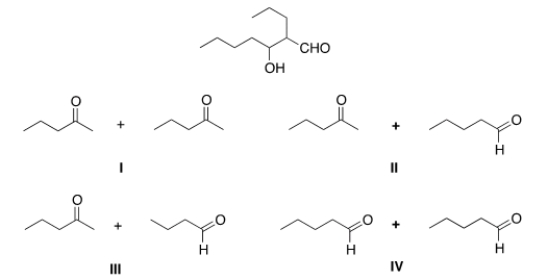
A) I
B) II
C) III
D) IV
Correct Answer

verified
Correct Answer
verified
Multiple Choice
What is the general name for the reaction product formed in a Claisen reaction?
A) "-hydroxy ester"
B) "-keto ester"
C) "-keto ester"
D) "-hydroxy ester"
Correct Answer

verified
Correct Answer
verified
Multiple Choice
What is the Aldol addition product formed from the reaction of acetone, (CH3) 2CO, with itself? 
A) I
B) II
C) III
D) IV
Correct Answer

verified
Correct Answer
verified
Multiple Choice
Which is the unsaturated carbonyl compound formed in the dehydration of the following -hydroxy carbonyl compound? 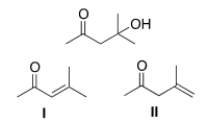
A) I
B) II
C) I and II
D) None of the choices
Correct Answer

verified
Correct Answer
verified
Multiple Choice
In the correct order, what are the three steps in the mechanism of an Aldol reaction?
A) Protonation, enolate formation, nucleophilic addition.
B) Enolate formation, protonation, nucleophilic addition.
C) Enolate formation, nucleophilic addition, protonation.
D) Nucleophilic addition, enolate formation, protonation.
Correct Answer

verified
Correct Answer
verified
Multiple Choice
What is the cyclic product formed in the intramolecular Aldol condensation when the following compound is treated with aqueous NaOH? 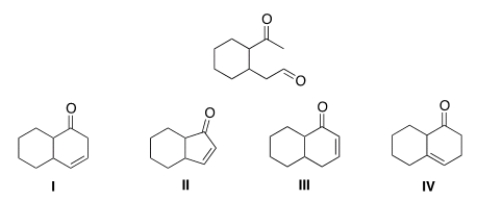
A) I
B) II
C) III
D) IV
Correct Answer

verified
Correct Answer
verified
Multiple Choice
What is the name given to the Claisen reaction between two different esters?
A) multiple Claisen reaction
B) differential Claisen reaction
C) crossed Claisen reaction
D) versatile Claisen reaction
Correct Answer

verified
Correct Answer
verified
Multiple Choice
Of the carbonyl compounds; (1) benzaldehyde, (2) acetophenone and (3) dicyclohexyl ketone, which compound has no -hydrogens?
A) benzaldehyde
B) acetophenone
C) acetone
D) All of these compounds contain -hydrogens
Correct Answer

verified
Correct Answer
verified
Multiple Choice
What is the product of the self-condensation of ethanal (acetaldehyde) , shown below? 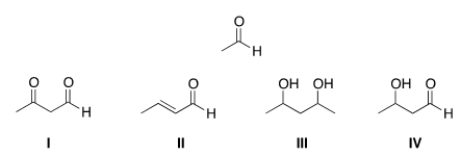
A) I
B) II
C) III
D) IV
Correct Answer

verified
Correct Answer
verified
Multiple Choice
What type of esters can undergo Claisen reactions?
A) All esters can undergo Claisen reactions.
B) Only esters with two hydrogen atoms on the carbon can undergo Claisen reactions.
C) Only esters with three hydrogen atoms on the carbon can undergo Claisen reactions.
D) Only esters with two or three hydrogen atoms on the carbon can undergo Claisen reactions.
Correct Answer

verified
Correct Answer
verified
Multiple Choice
There are several variations of the Aldol reaction. Which of the following types of reactants leads to only one possible product with the Aldol condensation reaction?
A) Two different aldehydes with -hydrogens are able to form a single aldol condensation product.
B) Two different ketones with -hydrogens are able to form a single aldol condensation product.
C) Any aldehyde and ketone mixed together can react to form a single condensation product.
D) Any pair of aldehyde or ketone reactants where one of the reactants has no -hydrogens will lead to a single aldol product.
Correct Answer

verified
Correct Answer
verified
Multiple Choice
What is an intramolecular Claisen reaction called?
A) Michael reaction
B) Robinson reaction
C) Hoffman reaction
D) Dieckmann reaction
Correct Answer

verified
Correct Answer
verified
Multiple Choice
What is the product of the following Claisen reaction? 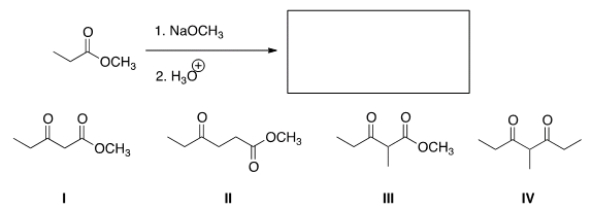
A) I
B) II
C) III
D) IV
Correct Answer

verified
Correct Answer
verified
Multiple Choice
What cyclic product is formed in the intramolecular Aldol condensation when the following compound is treated with aqueous NaOH? 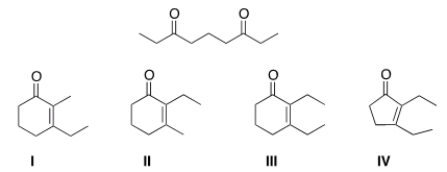
A) I
B) II
C) III
D) IV
Correct Answer

verified
Correct Answer
verified
Multiple Choice
What is the general name for the class of products formed in an Aldol condensation reaction?
A) ",-unsaturated carbonyl compound"
B) ",-unsaturated carbonyl compound"
C) ",-unsaturated carbonyl compound"
D) "-hydroxy carbonyl compound"
Correct Answer

verified
Correct Answer
verified
Multiple Choice
Which of the following compounds can undergo an Aldol with itself? 
A) I
B) II
C) III
D) Both I and II
Correct Answer

verified
Correct Answer
verified
Multiple Choice
What reaction type is a Claisen reaction?
A) Electrophilic addition
B) Electrophilic substitution
C) Nucleophilic addition
D) Nucleophilic substitution
Correct Answer

verified
Correct Answer
verified
Showing 21 - 40 of 45
Related Exams